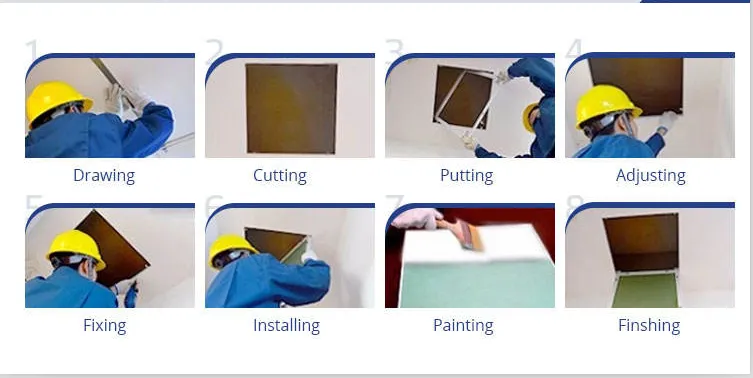9 月 . 29, 2024 03:31 Back to list
Exploring the Relationship Between Gypsum and PVC in Building Materials
The Synergy of Gypsum and PVC A Modern Solution in Construction
In recent years, the construction industry has significantly evolved, embracing innovative materials that enhance durability, aesthetics, and environmental sustainability. Among these materials, gypsum and polyvinyl chloride (PVC) have emerged as popular choices, each offering unique advantages. When combined, gypsum and PVC can create comprehensive solutions that address various construction needs, from interior design to sound insulation and fire resistance.
Understanding Gypsum and PVC
Gypsum is a naturally occurring mineral composed of calcium sulfate dihydrate. It has been used in construction for centuries, primarily in the form of gypsum board or drywall. This lightweight material is favored for its excellent fire resistance, soundproofing qualities, and ease of application. Gypsum board can be cut to size, making it ideal for various wall finishes and ceiling systems.
On the other hand, polyvinyl chloride, or PVC, is a synthetic plastic polymer. It is renowned for its versatility, durability, and resistance to moisture, chemicals, and corrosion. PVC is widely used in plumbing, electrical installations, flooring, and wall coverings. Additionally, its ability to be molded into various shapes and colors makes it a favored choice for decorative elements.
The Benefits of Combining Gypsum and PVC
When gypsum and PVC are combined, they create a composite material that harnesses the strengths of both substances. One of the primary advantages of this synergy is improved fire resistance. Gypsum’s inherent fire-resistant properties can complement PVC’s durability, making this combination suitable for applications in areas where fire safety is paramount, such as commercial buildings and public spaces.
Sound insulation is another significant benefit. Gypsum board is known for its acoustic properties, effectively reducing sound transmission between rooms. Adding PVC elements, such as window profiles or wall coverings, enhances soundproofing further due to PVC’s ability to dampen vibrations. This is particularly beneficial in residential buildings, hotels, and office spaces, where noise reduction is essential for comfort and productivity.
Moreover, combining these materials can result in a more streamlined construction process. Gypsum boards can be installed alongside PVC trim and moldings, allowing for cohesive design and quicker installation. This not only saves time but also reduces labor costs, contributing to the overall efficiency of construction projects.
gypsum pvc

Sustainability Matters
Sustainability is a growing concern in the construction industry, and both gypsum and PVC can contribute to eco-friendly building practices. Gypsum is a natural material that is abundantly available and can be sourced responsibly. It is also recyclable, as waste gypsum can be repurposed in various applications, reducing landfill contributions.
PVC, while a synthetic material, has seen advancements in sustainable production practices. Many manufacturers now produce recycled PVC, which helps to minimize environmental impact. Additionally, the durability of PVC means longer lifespans for building materials, reducing the need for frequent replacements and conserving resources over time.
Applications in Construction
The combination of gypsum and PVC is already finding applications across various construction sectors. In residential buildings, this synergy is utilized for creating modern, stylish interiors with seamless transitions between drywall and PVC elements. In commercial settings, it provides an effective solution for sound insulation and fire safety, vital for offices and public spaces.
Furthermore, the use of gypsum and PVC in infrastructure projects, such as schools and hospitals, can enhance both the functionality and aesthetics of these vital spaces. The ability to customize designs with colored and textured PVC trims, paired with the clean, smooth finish of gypsum boards, opens up creative opportunities for architects and designers.
Conclusion
In summary, the integration of gypsum and PVC in construction represents a forward-thinking approach to modern building practices. The combination leverages the unique benefits of both materials, providing solutions that are fire-resistant, soundproof, and environmentally sustainable. As the construction industry continues to innovate, the partnership between gypsum and PVC will undoubtedly play a crucial role in shaping the future of responsible and efficient building solutions. By embracing this synergy, builders can enhance the quality, safety, and sustainability of their projects, ultimately contributing to healthier and more resilient built environments.
-
Revolutionizing Interior Design with Ceilings t grid Suspended SystemNewsOct.29,2024
-
Revolutionizing Ceiling Design with ceiling access panel with Gypsum Tile WaterproofNewsOct.29,2024
-
Revolutionizing Interior Design with PVC Gypsum Ceiling: A Comprehensive GuideNewsOct.29,2024
-
Elevating Interior Design with High quality Mineral Fiber Ceiling TilesNewsOct.29,2024
-
Revolutionizing Interior Design with PVC Gypsum Ceiling: A Comprehensive GuideNewsOct.29,2024
-
Elevating Interior Design with High-Quality Mineral Fiber Ceiling Tiles: A Comprehensive GuideNewsOct.29,2024







